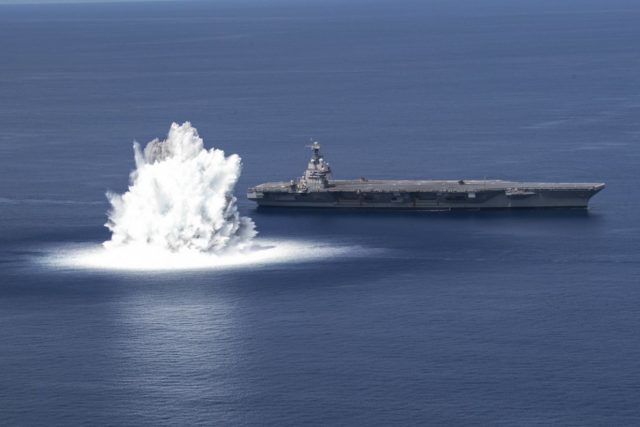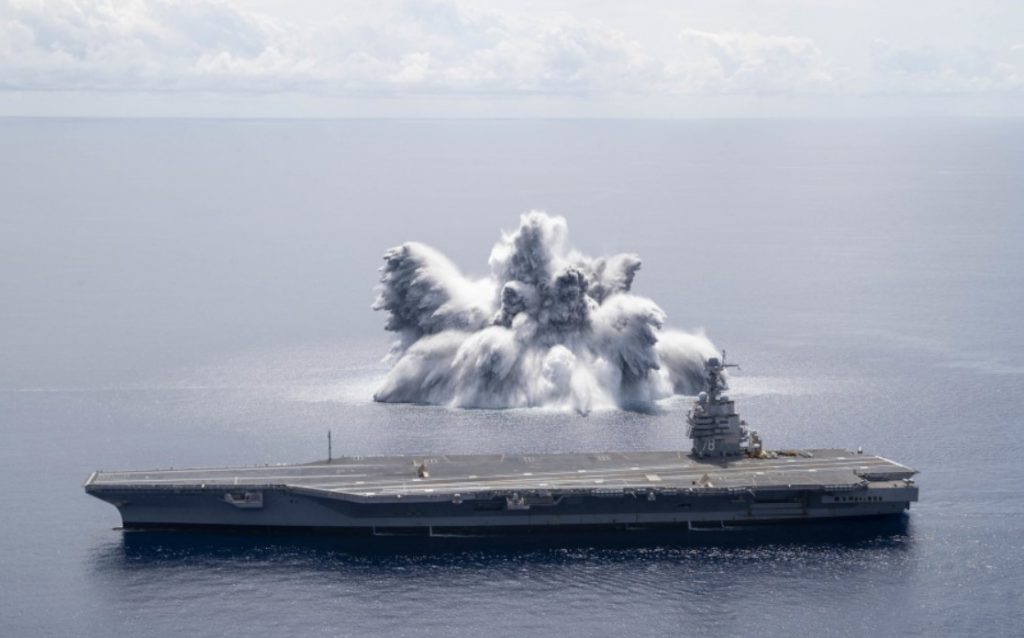
The US Navy has finally completed much anticipated full ship shock trials (FSST) for the lead ship of its next generation of Ford-class carriers.
According to the service, USS Gerald R. Ford (CVN 78) successfully completed the first scheduled explosive event as part of FSST on June 18.
Two more explosive trials are set to be carried out over the course of the next few days. They help the navy assess how a myriad of systems installed on the ship react to shock.
The first-in-class aircraft carrier was designed using advanced computer modeling methods, testing, and analysis to ensure the ship is hardened to withstand battle conditions, and these shock trials provide data used in validating the shock hardness of the ship.
The shock trials, which includes setting off explosive charges near the ship to assess its capability to handle battle scenarios, had been mandated by Congress as early as 2016. However, the Congress subsequently backed down to allow the navy to commission the ship in 2017.
It should also be noted that despite previous promises, which said the ship would undergo the trial with all of its new-design weapons elevators operational, four of the elevators were not working at the time of the trial. The elevator malfunctioning is one of several issues the navy has been tackling on board CVN 78, which is the service’s first new aircraft carrier design in 40 years.
The navy has also been working to address problems with other systems on the ship, including its propulsion and electrical systems. The ship’s electromagnetic aircraft launch system (EMALS) has also proven to be irksome, breaking down as late as summer 2020 during flight operations.
According to a Congressional Research Service report from December 2019, technical issues regarding the weapon elevators and other ship systems have delayed the ship’s first deployment to 2022 at the earliest, which would be about five years after the ship was commissioned into service.

The full ship shock ship trials are a standard method used by the navy to test its new ships. The service has conducted FSSTs over several decades, most recently for the Littoral Combat Ships USS Jackson (LCS 6) and USS Milwaukee (LCS 5) in 2016; as well as for the San Antonio-class amphibious transport dock USS Mesa Verde (LPD 19) in 2008, the amphibious assault ship USS Wasp (LHD 1) in 1990, and the guided missile cruiser USS Mobile Bay (CG 53) in 1987. The last aircraft carrier to execute FSST was USS Theodore Roosevelt (CVN 71) in 1987.
The navy is conducting the shock trial testing in accordance with Office of the Chief of Naval Operations Instruction 9072.2, and as mandated by the National Defense Authorization Act of 2016.
“Ford’s shock trials are being conducted off the East Coast of the United States, within a narrow schedule that complies with environmental mitigation requirements, respecting known migration patterns of marine life in the test area. The navy also has employed extensive protocols throughout FSST to ensure the safety of military and civilian personnel participating in the testing evolution, the service said in an announcement.
USS Gerald R. Ford closed out a successful 18-month post delivery test & trials period in April, during which the crew completed all required testing, accomplished planned improvements and maintenance ahead of schedule. At the same time, the ship also served as the sole East Coast platform for conducting carrier qualifications.
Upon completion of FSST later this summer, Ford will enter a planned incremental availability for six months of modernization, maintenance, and repairs prior to its operational employment.


























